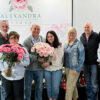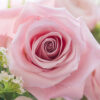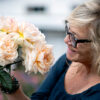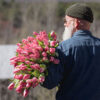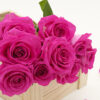Ok, even though we’re a week into Spring and everyone is looking forward to Easter and Mother’s Day, I still thought it would be appropriate to share some results of the 2010 Christmas Sales survey SAF did. After all, it was below freezing this morning when I walked out of my house!
Christmas 2010 Sales Results
By Ira Silvergleit
The Christmas season got a little bit of its jolly back this year for many florists, as sales rebounded from 2009. Half of retail florists who responded to SAF’s post Christmas survey reported sales increases in 2010 over 2009. Last year, 36 percent reported an uptick in year over year sales. About 23 percent held steady and 26 percent reported a decline in sales ‑‑ quite a contrast from the 44 percent who reported declines for Christmas 2009. The average increase at shops with an uptick was 9 percent.Overall retail spending was up 5.5 percent this Christmas season, according to a MasterCard survey. In fact, just about every retail category saw an increase, an unusual cross-the-boards spike. The results exceeded predictions by the National Retail Federation, which had predicted increases of 3.3 percent, and ShopperTrak, which forecast a 4 percent gainOnline holiday shopping exceeded the gains of traditional brick and mortar businesses
Size, LocationWhen the results are broken out by the size of shops as measured by annual sales levels, the largest businesses, those with annual sales of $1 million or more, were most likely to report increases (58 percent versus 49 percent overall) in 2010. In terms of shop location, sales gains were most reported by shops in the suburbs (55 percent) and rural locations (53 percent). Though this may seem inconsistent, rural shops were also more likely to report declines along with urban shops than were businesses in suburban and small town locations. (The small percentage of rural shops reporting sales about equal to last year allowed them to be relatively high in both gains and declines.) In 2010, for shops reporting an uptick, the average increase was 9 percent, about the same as in 2009. For shops reporting declines, the average dip was 14 percent, an improvement over the 18 percent average drop in 2009.
Just under 13 percent of holiday sales came from web orders, e-mails and faxes (not including incoming wire orders) — up about 1.5 percentage points over last year and 2008.
|
 Florists attributed gains mostly to (in order): increased shop reputation, better word-of-mouth or buzz, and increased online, walk-in and wire-in sales, among other factors. Additional reasons given by more than 10 percent of florists, but not shown in the chart, include product availability, the national economy, improved product mix, fewer competitors, price points, discount coupons, social media efforts, event and party work, and corporate business. Florists were allowed to add their own sale-boosting factors, not included on the list. They cited increased advertising, postcard campaigns, open houses, extended hours, higher average sales, more gift sales, additional funeral work, church poinsettia sales and wine sales. On the subject of open houses, 39 percent of shops did hold a holiday open house or similar holiday-themed event based on results of a specific question asked on the survey. Florists attributed gains mostly to (in order): increased shop reputation, better word-of-mouth or buzz, and increased online, walk-in and wire-in sales, among other factors. Additional reasons given by more than 10 percent of florists, but not shown in the chart, include product availability, the national economy, improved product mix, fewer competitors, price points, discount coupons, social media efforts, event and party work, and corporate business. Florists were allowed to add their own sale-boosting factors, not included on the list. They cited increased advertising, postcard campaigns, open houses, extended hours, higher average sales, more gift sales, additional funeral work, church poinsettia sales and wine sales. On the subject of open houses, 39 percent of shops did hold a holiday open house or similar holiday-themed event based on results of a specific question asked on the survey.  Shop owners who reported declines attributed them to the national and regional economies, a general decline in corporate gift orders, and competition from supermarkets and mass marketers, order gatherers and online florists, among other factors. Shop owners who reported declines attributed them to the national and regional economies, a general decline in corporate gift orders, and competition from supermarkets and mass marketers, order gatherers and online florists, among other factors.
The biggest change from last year, and the only one to reach double digits, is the 16 percentage point increase in florists attributing sales decreases to competition from supermarkets and mass marketers, which increased from 30 percent to 46 percent. Other reasons for sales declines chosen by more than 10 percent of florists, but not included on the chart, are cost of goods, fuel and delivery costs, insufficient industry promotion, fewer online orders, wire-service offerings, heating and energy costs, dropped wire services (presumably resulting in fewer wire orders), and a reduction in wedding and event work. Florists added their own reasons, which echoed a still sluggish economy in their area, including fewer parties, fewer shop locations and unemployment rates. Other florists blamed wire-service promotions that promised delivery dates they couldn’t fulfill, competition from local grocery stores for wire orders and a general lack of consumer interest in flowers. The average Christmas transaction rose about $1 to $52.05 this year, compared to $50.99 in 2009 and $50.60 in 2008. In 2007 and 2006, the average transactions were about $51.25.
Competition for flower and plant customers was intense this holiday season, with most coming from order gatherers (21 percent), other local florists (17 percent), supermarkets (15 percent), mass merchandisers (13 percent) and online florists (8 percent) Marketing EffortsPromotional efforts remained steady for about 60 percent of florists. A third boosted marketing efforts and less than 5 percent cut back. Wire-service arrangements were featured in 61 percent of promotions, followed by store arrangements (57 percent). Poinsettias and seasonal plants were featured at 56 percent, (down 9 percentage points from 2009) and custom arrangements (49 percent). Indoor signage, posters or displays were the most popular marketing vehicles (61 percent), followed by window displays (58 percent). These were followed by a tie between statement stuffers/mailers, Facebook (49 percent each), e-mail promotions/campaigns (47 percent) and website promotions (46 percent). In addition to Facebook, other social media newcomers include Twitter (12 percent), blogs (8 percent) and LinkedIn (4 percent). The results were comparable to those in 2009. The most changed was a decrease in the use of newspaper/magazine advertising and an increase in online ads, including banner ads and the debut of Facebook and other specific social media categories. Poinsettias Poinsettias, once a staple of the season, seem to have hit a plateau for flower shops. Sales fell at 40 percent of shops and rose at 19 percent of shops — almost exactly the same breakdown reported last year.
For shops reporting increases, the average increase was 9 percent. Reported decreases averaged 17 percent.
Where do florists see poinsettia sales heading? About half (49 percent, which is slightly more than last year) said they perceived the five-year trend of declining sales was continuing, while far fewer said the trend could turn around (8 percent). Fourteen percent said sales were irregular (up and down in various years) and 26 percent said they were flat.
Red poinsettias remain the top seller, accounting for 80 percent of sales at two-thirds of the shops. For a quarter, reds accounted for more than half, but less than 80 percent of sales. According to the U.S. Department of Agriculture, domestic poinsettia production fell to 34.5 million pots in 2009 from 35.3 million in 2008. The number of producers fell from 766 to 695. Staffing Just under half of the shops decided not to add staff for the holidays, compared to 56 percent who refrained in 2009. Of those that did hire this year, 36 percent hired at the most two people. Three or more people joined the holiday staff at 15 percent of the shops. Holiday Hours Just 3 percent of shops were open Christmas and 6 percent on New Year’s Day. On the day before each holiday, between 35 and 36 percent were open their regular hours. Between 55 percent and 60 percent were open part of the day.
|
| Source: SAF Christmas and Valentine’s Intensions Survey, 2011. Responses based on 322 responses from retail florists (Response rate 9 percent). |
| Ira Silvergleit is SAF’s director of research and information services. |









 Almost six in 10 (58 percent) of florists offer holiday décor services, with business and home decor the most popular.
Almost six in 10 (58 percent) of florists offer holiday décor services, with business and home decor the most popular.